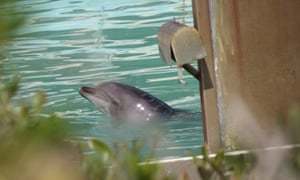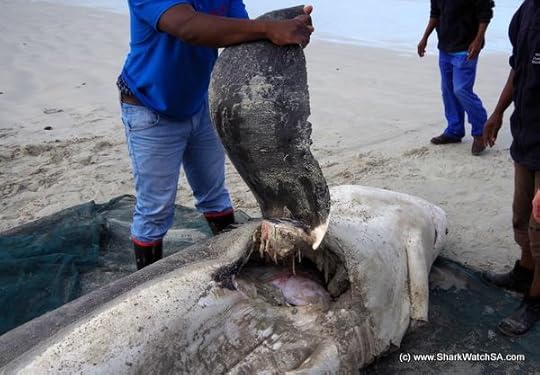Mark Caney's Blog, page 7
August 31, 2018
Dolphin and penguins locked in derelict Japan aquarium
Anger is mounting in Japan after a dolphin, 46 penguins and hundreds of fish were found to have been abandoned for months in a derelict aquarium.

Animal rights campaigners have warned that the marine animals could die if they are not rescued from the Inubosaki marine park aquarium in the Pacific coastal town of Choshi north-east of Tokyo.
The plight of Honey, a female bottlenose dolphin, as well as scores of Humboldt penguins and hundreds of fish and reptiles, has triggered outrage following reports that they were abandoned when the facility closed seven months ago.
Images taken from outside the marine park in March this year show the solitary dolphin languishing in a tiny pool. In another photograph, dishevelled-looking penguins can be seen perched on a structure near what appear to be piles of loose concrete.
The marine park closed at the end of January following a dramatic drop in visitor numbers blamed on the earthquake and tsunami that struck Japan’s north-east in March 2011.
Reports said employees of the marine park were feeding the animals, although it is unclear how they are sourcing food and how much they have left. It is possible that the park still has large stocks of frozen food or that employees are purchasing fresh fish in Choshi, a fishing port.
Animal rights campaigners have been refused entry to the facility, while local authorities have been unable to contact its private owner, Inubosaki Marine Park. Calls to the park’s owner went unanswered.
“I am worried that Honey will die if this situation continues,” Akiko Mitsunobu, head of aquarium issues at the Animal Rights Centre Japan, told the Guardian. “Lately she has just been repeating the same movements – dipping her head in and out of the water – and is showing definite signs of stress.”
In 2015, the Japan Association of Zoos and Aquariums agreed to stop buying dolphins from Taiji after it was threatened with expulsion from the World Association of Zoos and Aquariums (Waza).
The move came after the Guardian revealed that Waza had been targeted in a court action launched by the conservation group Australia for Dolphins, which accused it of being complicit in the hunts by failing to take decisive action against Japanese aquariums.
Aquariums in Japan voted to stop buying live specimens from Taiji to avoid expulsion, but a facility in the town quit Jaza in protest, and local fishermen have vowed to continue the hunts.
Full story: The Guardian

July 22, 2018
Beautiful Dolphin Footage
When you see a video like this, do you ever wonder what happens in the dolphins’ world? What they may be saying to each other?
Explore the possibilities with the book, Dolphin Way.

July 18, 2018
A German fan’s review of Dolphin Way
Dear Mr Caney
It is I, a German woman who finished reading your book a few days ago. I`m really thankful to have learned English, when I saw the interesting book cover of your book on Amazon.
I would have missed an amazing novel if I couldn´t.
“Dolphin Way- Rise of the Guardians” was a truly fascinating story. The effort you put into the plot was palpable on every page. Whenever a novel with animals as protagonists is written I wonder: How much – as I call it – intelligent anthropomorphism is in it? The answer for your novel would be: Fascinating. I really, really liked the idea of dolphins interpreting the shades in the water as a way of fortune telling. Very clever idea. I chuckled when I read that “the moving lights” in the sky which appeared fifty years ago are interpreted as water filled orbs with beings who travel in them. That was really funny. If I were a dolphin and thought about planes I would probably come to the same conclusion.
I also want to applaud you for giving the dolphins of your novel an actual character and not portraying them as “permanently friendly, in-love-with-every-human plush-toy of the ocean”. I`m sick of that. Dolphins are magnificent predators who have the right to be portrayed like you do.
Also kudos for letting characters die. Okay I admit that sounds cynical but as much as I like stories where everyone survives the drama reaches new heights when characters die. I felt sorry for almost everyone who died in the first part of your trilogy. Except a certain traitor.
The next thing I liked was, that you know how to let the reader assume something only show a few pages later, that you successfully fooled them. The dialogue between Sky and “One Eye” before and after they swam through the cave got me perking my eyebrows up.
I can`t wait to read “captured”, I really, really need to know what happens next. On the other hand I`m frightened for Sky. The poor lad was put through quite a bit in the first part already. I`m curious if Sky meets “Ah-Nah” in the sequel, I wouldn`t be surprised if he did.
Well whatever I guess I will just have to wait.
Greetings from a German fan

May 18, 2018
Text from Dolphin Way is featured on Quotations Website
Quotations.io has featured this short poem that introduces one of the chapters in the novel Dolphin Way. Every chapter in the book begins with a short excerpt like this, illustrating an aspect of the dolphin history and culture.
I would not wish it unblemished
Each wound carved your strength

April 29, 2018
Crafty Green Poet Reviews Dolphin Way
The latest review of Dolphin Way is from the Crafty Green Poet:
Rise of the Guardians is book one in the Dolphin Way series, Mark Caney’s beautifully imagined exploration of how life must be like for dolphins.
The novel follows Sky, a young male dolphin grappling with the challenges of remaining true to traditional dolphin beliefs in the face of a changing ocean. Dolphin society is split as to whether the ocean is changing due to the greed of other marine species or the unknown activities of the Walkers (ie humans).
Sky embarks on an adventure to outwit the Guardians, a cult like group who have abandoned the traditional dolphin values and who thus threaten to undermine dolphin culture. On the way he falls in love, is injured and makes enemies.
It’s a very engaging book, which feels as though it offers real insights into life as a dolphin and is exciting and moving at the same time. Crafty Green Boyfriend felt that the environmental message was handled too heavily (though he hasn’t yet read the whole book!) but I thought that by looking at everything from a dolphin’s perspective, the reader is more willing to pay attention to the urgent issues facing our oceans and the creatures that live there.

October 8, 2017
June 6, 2017
Win a copy of Dolphin Way in free competition
.goodreadsGiveawayWidget { color: #555; font-family: georgia, serif; font-weight: normal; text-align: left; font-size: 14px;
font-style: normal; background: white; }
.goodreadsGiveawayWidget p { margin: 0 0 .5em !important; padding: 0; }
.goodreadsGiveawayWidgetEnterLink {
display: inline-block;
color: #181818;
background-color: #F6F6EE;
border: 1px solid #9D8A78;
border-radius: 3px;
font-family: "Helvetica Neue", Helvetica, Arial, sans-serif;
font-weight: bold;
text-decoration: none;
outline: none;
font-size: 13px;
padding: 8px 12px;
}
.goodreadsGiveawayWidgetEnterLink:hover {
color: #181818;
background-color: #F7F2ED;
border: 1px solid #AFAFAF;
text-decoration: none;
}
Goodreads Book Giveaway

Dolphin Way
by Mark Caney
Giveaway ends July 04, 2017.
See the giveaway details
at Goodreads.

May 31, 2017
May 11, 2017
Orcas kill Great White Sharks
A team of scientists from the area dissected all three of the sharks, and concluded that orcas were responsible for killing the great whites and removing their livers. (One also had its heart removed, likely by a hungry killer whale.) This organ has a high level of squalene, a hydrocarbon that’s an important for producing steroids and hormones.
“Obviously this is a very sad time for us all, nature can be so cruel and the dexterity these enormous animals are capable of is mind blowing, almost surgical precision as they remove the squalene rich liver of the white sharks and dump their carcass,” writes Alison Towner, a white shark biologist for the Dyer Island Conservation Trust who led the dissections, in the Marine Dynamics blog.

Orcas are very smart, and have different behaviors for hunting different animals around the world. It is possible that the creatures have now learned to go after killer whales. In 1997, whale watchers off the coast of San Francisco, near the Farallon Islands, filmed a killer whale attacking a great white, after flipping it over.
When turned upside down, many sharks become nearly comatose, and thus easy prey. Samuel Gruber, a researcher at the Bimini Biological Field Station in the Bahamas, said orcas could develop and spread new such hunting tricks. “Their learning abilities are so great, that if one of them happened to” flip over and stun a shark, “and see that [sharks freeze up] in this state, they could communicate it to the other ones,” Gruber says in a National Geographic film.
Full story: Newsweek

February 28, 2017
Humans Are Being Taught to Echolocate Like Dolphins – and It’s Surprisingly Easy
Scientists have successfully taught a small group of blind and sighted people how to navigate their surroundings using echolocation – the sonar-based language of dolphins and bats.
Using sound created by tongue clicks, the group learned how to detect the size of virtual rooms with surprising accuracy – something that researchers had not expected in people who were born with sight.
While blind people have proven successful at echolocation in the past, it’s been unclear if sighted people can develop the same ability, given their almost total dependence on visual perception.
“We thought, ‘If it’s sighted people, it’s not going to be something we’ve ever learned to do, so probably we’re really bad at it,'” one of the team, Virginia Flanagin from the Ludwig Maximilian University of Munich, Germany, told Veronique Greenwood at The Atlantic.
But the results showed the opposite – in an experiment involving 11 sighted people and one blind person, the best-performing sighted person could use echolocation to detect a mere 4 percent difference in the size of a virtual room.
“Even the people who did less well could still often tell apart differences of 6 to 8 percent, with the least skilled bottoming out at a 16 percent difference,” Greenwood reports.
“Overall, that actually is about the same level of acuity – ability to distinguish differences – that you find in some visual tests, says Flanagin.”
To figure this out, the team first trained their subjects in echolocation by placing them in a heavily padded anechoic chamber, and playing recordings of clicks made previously in real-life buildings.
By running the exercise in a room that produces no echoes of its own, the researchers could tell the participants which sounds correlated to larger or smaller rooms, giving them the opportunity to learn the subtle differences between the two.
Once the volunteers had gotten through the initial training, the team hooked them into an MRI machine, which was connected to a virtual, 3D model of a nearby chapel building.
The volunteers would either click their tongue to make a sound, or the machine would make the sound for them – referred to as “active” and “passive” echolocation – and listen for how those sounds echoed through the virtual room.
Based on these echoes, the volunteers would have to judge the size of the virtual room.
The researchers found that the volunteers all did significantly better when they were performing active echolocation – meaning their own clicks were a far more effective tool for them to navigate their virtual surroundings.
That makes sense, seeing as the volunteers were more actively engaged in the exhalation when they were the ones performing it, but what the researchers found strange was that the sound of the echoes activated the sighted volunteers’ motor cortex – the region of the brain responsible for movement.
Even when the team compared MRI scans from active and passive echolocation – allowing them to isolate and remove the brain activity involved in actually making the physical clicking sound – that part of the brain still showed signs of life.
In fact, the motor cortex was found to be most active with large versions of the chapel than smaller ones, Greenwood reports, which suggests a connection between virtually navigating and physically navigating a space.
“It seems like the motor cortex is somehow involved in the sensory processing,” Flanagin told her.
In the blind subject, the echoes activated the unused visual cortex instead, suggesting that they were visualising the echoes as they bounced between the virtual walls.
We should note that the study is extremely small, with a limited sample size of both blind and sighted people, so we can’t read too much into the results until they have been replicated in a much larger, more diverse group.
But based on what we know about human echolocation already, it suggests that sighted people do have the capacity for this purely sound-based form of navigation.
You can watch one of the most famous human echolocation experts, Daniel Kish, demonstrate his ability riding a bike in the video below:
The research has been published in the Journal of Neuroscience.
Source: Science Alert






